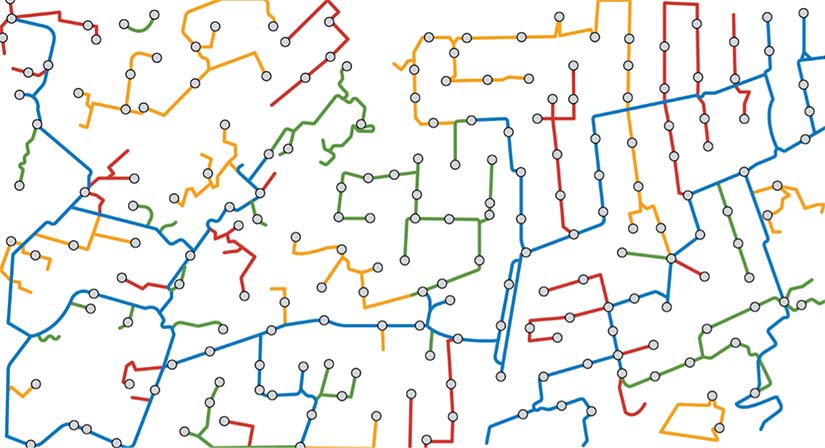Hosting Capacity Analysis Data Validation
NREL's suite of data validation best practices helps hosting capacity analyses (HCAs) produce trustworthy and reliable results that accurately reflect real-world grid conditions.
NREL, in partnership with the Interstate Renewable Energy Council (IREC), identified procedural and technical practices for utilities, regulators, and stakeholders to help overcome common HCA challenges.

What Is Hosting Capacity Analysis?
Solar generation, energy storage, electric vehicles, and other renewable distributed energy resources (DERs) are arriving on the electric distribution grid in fast-growing numbers, but it is not always clear how much incremental DER capacity the distribution system can accommodate. Clarity about grid capacity is of special importance to utilities, developers, and regulators, as well as customers, who are adding more DERs and require accurate, accessible, and trustworthy information.
Such information can be gathered through a hosting capacity analysis, a process used by utilities and regulators to determine the available capacity for new DERs without requiring expensive and time-consuming studies or grid upgrades. An HCA provides a snapshot of a distribution grid's current ability to interconnect these resources and helps inform stakeholders as they make strategic grid investments in their communities. When performed properly, an HCA can streamline and add transparency to DER planning and interconnection processes.
Data Validation for Hosting Capacity Analyses
To improve HCA data and avoid the common challenges encountered in previous analyses, NREL and IREC compiled best practices for HCA data validation, which can be beneficial for:
- Utilities, to develop or refine their HCA data validation procedures
- Regulators, to inform their oversight of utilities' HCA data validation practices
- Other stakeholders, to evaluate the effectiveness of utility efforts.
Hosting Capacity Analyses Team
Each HCA benefits from dedicated attention. A specific HCA manager, supported by a well-resourced team, is the first step in a successful and efficient analysis process. The designated HCA manager oversees data validation, including establishing and tracking metrics to assess the quality of HCA data and results and ensuring the HCA process functions efficiently altogether. See the full report for a description of the business processes proposed to thoroughly validate HCA data, including a detailed list of quality metrics to track and tips for appropriate resourcing.
Feeder Model Validation Process
A feeder model is a digital representation of a part of the distribution system designed to match the characteristics of the feeder in the physical world. Feeder model development is also the most error-prone stage of any HCA.
To address this, the team identified repeatable and streamlined processes to check and correct model input errors. The full report includes tables with specific examples of validation procedures for each step in the feeder model building process, which can be standardized and follow well-documented steps:
- Feeders that experience similar challenges would benefit from being batched so that engineers can easily develop solutions to common problems.
- Scripting can be used to automate error correction when building feeder models and to significantly accelerate decision making. Code base management tools are effective in preventing and resolving errors because they allow utilities to track the evolution of code and quickly revert to previous versions if needed.
- Using actual—not estimated—customer consumption data improves data accuracy. Existing commercial software, versus tools developed in-house, also provide an advantage in managing consumption profiles because they typically include helpful data validation features.
- Instead of attempting to perform the power flow simulations for an entire year and an entire service area at once, the research team proposes examining a prioritized set of load hours and a representative sample of feeders first.
Transparency
To maximize efficiency and effective public oversight, the HCA process can include measures that prioritize transparency and feedback to help catch errors and elevate confidence in HCA results. Suggested measures detailed in the full report include a review process to flag irregularities before publication as well as a mechanism to allow customers and HCA data users to offer feedback about user experience, identified errors, and usefulness of the HCA data.
Likewise, it is a best practice for regulators to provide transparency into the data validation process. This could be done by reviewing and requiring improvements to data validation plans, tracking the quality of HCA results over time with metrics that describe data quality, and requiring a root cause analysis for recurring problems in the HCA process.
Full Report
The full report identifies best practices for HCA business processes, examples of data validation procedures, specific rules for identifying data errors, and suggestions for regulatory oversight. Using these processes, utilities and regulators can provide confidence that HCA results accurately reflect grid conditions. With that confidence, trusted HCA data can be used in modernized DER planning and interconnection processes.
Supporting Data and Analysis
Learn more about NREL's advanced hosting capacity analysis capabilities and explore IREC's additional HCA resources:
Key Decisions for Hosting Capacity Analyses, IREC (2021)
Optimizing the Grid: Regulator's Guide to Hosting Capacity Analyses, IREC (2017)
Contact
Share

